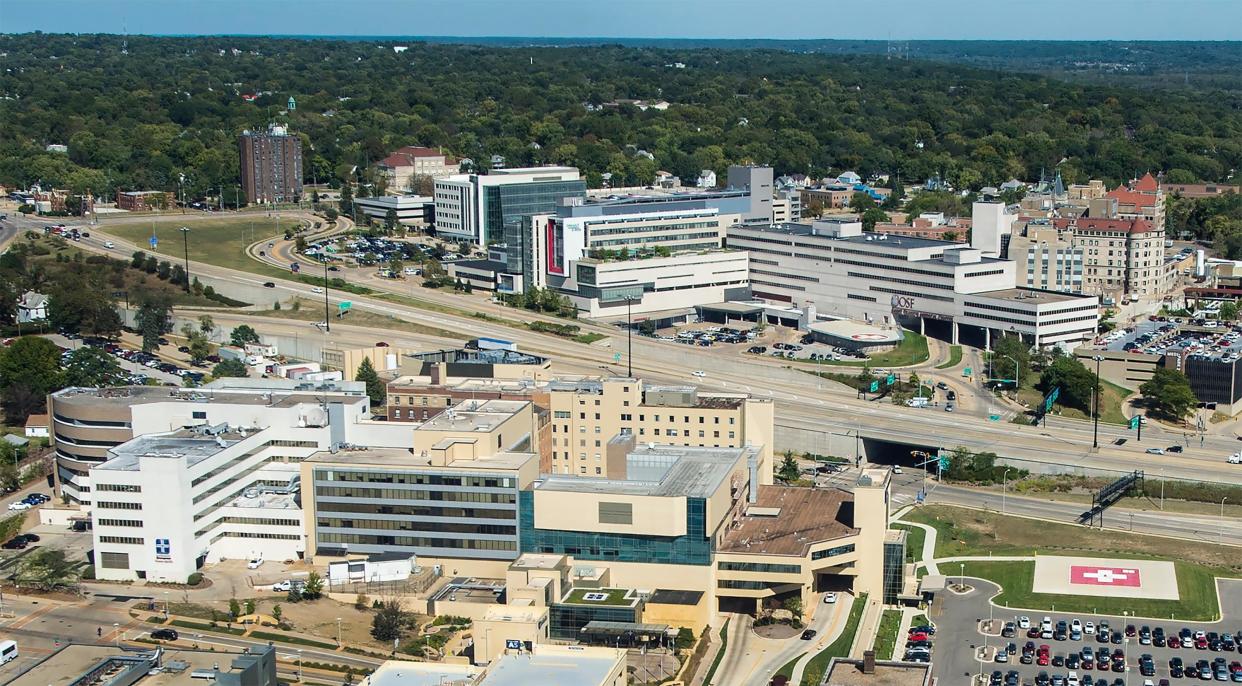Peoria hospitals not fully complying with price transparency law, according to report

PEORIA — Two and a half years after a federal law went into effect requiring hospitals to provide a comprehensive list of prices, neither OSF HealthCare nor Carle Health are in full compliance, according to a nonprofit organization fighting for price transparency in the U.S. health care industry.
Peoria's two hospital systems are among the 60% of hospitals in Illinois failing to provide a clear and comprehensive list of medical charges, according to a report compiled by Patient Rights Advocate.
“The American people are being harmed every day by not being able to benefit from knowing competitive prices for the same care,” said Cynthia Fisher, founder and chairman of Patient Rights Advocate. "Price transparency shifts power from the big industrial medical complex, hospitals, insurers, big pharma and private equity, which is invested in all of them, and it shifts it to the true purchasers of all health care, which is the employer and the unions, and all of us who buy coverage and pay for care.”
Missing information and unreadable files
After years of legal wrangling, a federal law forcing hospitals to post prices went into effect on Jan. 1, 2021. Compliance has been poor. According to Patient Rights Advocate's most recent survey, only 36% of hospitals in the U.S. are in full compliance with the legislation. In Illinois, only 30 of 75 hospitals have provided complete price lists.
To see what a price list should look like, Fisher pointed to the one compiled by Rush University Medical Center in Chicago.
“It’s so easy, you and I can read it,” she said.
While it takes time for the large file to open, the spreadsheet presents each item along with accompanying codes in an easily readable format. Each item has the price, the minimum and maximum negotiated price, the discounted cash price, and what each insurance company has negotiated to pay.
More: 'This has been my dream': Peoria nurse navigates challenges to open memory care facility
Not all hospitals have elected to make their lists readable, however. OSF HealthCare St. Francis Medical Center’s list is not readable at all. The page comes up as a long list of words, numbers, and codes running together, then disappears and is replaced with an error code. Anyone who can actually open the price list for OSF St. Francis Medical Center would find that data is missing, said Fisher.
“They are missing a fair amount of the negotiated rates, and they are also not showing the minimum price that they’ve negotiated for that same service, by plan, and the maximum price by plan that they’ve negotiated,” said Fisher. “That means when you call up the file, we can’t find the range that says, OK, an MRI might be priced at $300 and it may be $5,400 based upon the plan. So, if your plan negotiated a $300 rate, you say, ‘Wow, they did a good job.’ And if you got a $5,400 rate for an MRI, you’re going to say, ‘My insurance carrier is doing a really bad job and they’re overcharging me in that hospital because you know that hospital is making money at $300 — they're not going to give you a price where they’re going to lose money.’ So, it’s important to see the range — it's part of the great reveal.”
While a readable list of prices for common procedures at OSF HealthCare is available via its online My Chart tool, that list does not provide negotiated rates.
OSF HealthCare did not explain or offer to help when the Journal Star could not open its online price list, but it did provide the following statement:
"OSF HealthCare is a Catholic mission that is committed to serving our communities with high quality healthcare services. Consistent with our mission and values, we deliver that care in an ethical way by complying with applicable federal and state requirements. With respect to price transparency, we have provided all of the standard charge data elements required by the Centers for Medicare & Medicaid Services through the federal hospital price transparency rule. The data elements are provided in a consumer-friendly web-based patient estimation tool and also disclosed in a comprehensive single machine-readable file."
OSF HealthCare questioned the accuracy of the Patient Rights Advocate report, pointing to the American Hospital Association statement that it “misconstrues, ignores and mischaracterizes hospital compliance with the federal price transparency regulations.” OSF HealthCare also said that, in a recent survey, the Centers for Medicare & Medicaid Services — the federal agency tasked with enforcing the law — found 70% of hospitals in compliance with both parts of the law, and 82% in compliance with at least one component of the law. For that report, CMS randomly surveyed 600 hospital websites. There are more than 6,000 hospitals in the U.S.
Carle Health’s price list for Methodist Hospital loads correctly and is readable, but Fisher said it’s missing key information.
“They weren’t showing all of the negotiated rates for every payer and plan," she said. “It was missing swaths of data, a significant percentage of prices were missing from the comparative negotiated rate. What does that mean? A lot of people who go to that hospital would not be able to find the charges for a specific procedure, like a colonoscopy, under their plan.”
Asked to comment for this story, Carle Health also referred to the American Hospital Association's assessment that Patient Rights Advocate's report “misconstrues, ignores and mischaracterizes hospital compliance with the federal price transparency regulations.” Carle Health also issued the following statement:
“Carle Health is committed to helping patients make informed choices about their care and meets all required steps to provide the most accurate and current information for their decision-making. Carle Health patients have access to our standard charges and a price estimator tool in conformity with price transparency requirements.”
A health care revolution

Medical systems and insurance companies have fought hard against “the great reveal” because it will revolutionize the American health care system, said Fisher. Properly prepared spreadsheets will allow search engines to aggregate data, and consumers will be able to easily price shop for medical care online.
“Right now, hospitals and insurance companies have made it very difficult for us to be able to plan, to find the actual prices that they have made in backroom deals,” she said. “They made these deals in the shadows, and they want to keep it in the shadows. They sued the federal government to keep it in the shadows and they lost. They lost in the upper courts and in the appellate courts."
More: OSF HealthCare is reopening some closed medical clinics in Peru, Illinois
Price lists allow consumers to not only see what hospitals are charging, but also to see if their insurance company has done a good job.
"As of a year ago, insurance companies had to provide every employer plan with all of the negotiated rates in their entire network wherever they have negotiated, within the hospital and outside of the hospital, and the out-of-network rates so that every employer could design a plan that’s going to find better quality of care at a much lower cost,” Fisher said.
Ultimately, transparency will lead to lower prices across the board, she said.
“This is the beginning of the American Revolution in health care. Price transparency shifts that power to the consumers — you and me, employers and the unions — that now have the right to stand up for their earnings and the wages of their workers to stop being overcharged, overbilled, and totally depleted by our health care system that makes our country not competitive with other countries," said Fisher. "We lose jobs to overseas because the other countries don’t game their health care.”
What are we learning from price lists?
Price lists are revealing the fact that the numbers vary wildly from hospital to hospital, and insurance company to insurance company.
Fisher related a real-life example of disparate pricing. A Massachusetts woman who tore her ACL skiing in Colorado got an estimate of nearly $99,000 for surgery to repair it. Because she was insured under her parents' policy, they told her to come home for the procedure to save the out-of-network charges. When she told the hospital of her plan to go elsewhere, the surgeon who was to perform the procedure offered to do it in his new ambulatory surgical center for just $7,000. The patient also saved money by price shopping for the brace she needed to wear post-surgery. When she learned it would be $1,500 through her medical provider, she went to Amazon.com and found the exact same brace for $150, said Fisher.
Perhaps the most disturbing thing price lists are revealing is that sometimes it's cheaper to skip the insurance company altogether.
“Oftentimes we are finding that the discounted cash price is far lower than the lowest insured rate,” said Fisher. Her organization learned of a situation where a medically necessary breast reduction cost $57,000 through the patient’s insurance company, and only $10,000 if the patient skipped the insurance company and paid out of pocket.
Are hospitals getting in trouble for not complying with the new law?
Hospitals can be fined for noncompliance by the Centers for Medicare & Medicaid Services, the federal agency charged with enforcing the law.
“The federal government has been slow to enforce the law,” said Fisher. “They can easily issue the $2 million fine and ask for remedy and recourse, and when they have given the high-level fines of over a million dollars, those hospitals — two of them — came into compliance right away. Most of the fines have been around $100,000. Hospitals can make more than that with an erroneous bill on any given day, so why should they fix the pricing file? We need robust, timely enforcement, and we need the federal government to do it.”
Frustrated with the lag in enforcement, more than 20 states are in the process of writing legislation to tackle the problem, said Fisher.
“There’s legislation being drafted to use deceptive trade practices and consumer protection issues to get hospitals to provide all the actual prices. And if they don’t provide them to consumers, you have the right to not pay the bill, or for the state to fine the hospitals.”
Leslie Renken can be reached at (309) 370-5087 or lrenken@pjstar.com. Follow her on Facebook.com/leslie.renken.
This article originally appeared on Journal Star: OSF, Carle Health not fully following federal price transparency law


